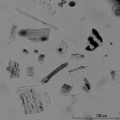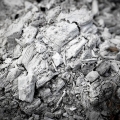
Plant phytoliths
Many plants produce minerals composed of silica (also known as opal). These so-called phytoliths (see Figure 1) are known to occlude organic material inside the mineral phase, where it is relatively protected from bacterial or fungal attacks. Despite many efforts over the years, is has proven very difficult to extract this organic material from silica minerals for radiocarbon dating.
Dr. Yotam Asscher, a PhD graduate supervised by Prof. Steve Weiner and Prof. Boaretto, utilized a different approach. He dissolved the silica under mild conditions, and then extracted the insoluble organic fraction from the phytoliths. After cleaning and graphitization, this organic material was dated. In order to determine whether the dates are reliable or not, phytoliths were tested from a sequence of layers that also contained charred seeds. The results show that the dates are accurate to within a 100 years or so, but in some cases they are identical to the ages of the charred seeds. The cases where they are identical were shown to be those samples that produced a high yield of carbon, indicating that they were composed almost entirely of cellulose. This study was published in Journal of Archaeological Science in February 2017.
Image on the left: Purified archaeological phytoliths from Beth Shemesh Layer
Credit: Journal of Archaeological Science, Volume 78, February 2017, Pages 57-65.

“High temperature” aragonite
Dr. Michael Toffolo, a former PhD student supervised by Dr. Boaretto, made a seminal discovery during his PhD research at the Weizmann Institute. Calcite in the form of limestone decomposes by heating to around 800 °C to form calcium oxide. The calcium oxide then hydrates and finally takes up carbon dioxide to form calcite again, but now in the form of plaster or mortar. Even though this reaction sequence is probably one of the most studied chemical reactions in scientific history, and despite its known use in the production of cement and concrete, what has thus far eluded the scientific community is that during this equilibration with water and carbon dioxide, another form of calcite – called aragonite – is sometimes also produced. The aragonite, whose appearance was detected by Dr. Toffolo, often transforms into calcite, but in some cases aragonite can be preserved for millennia in certain layers of archaeological sites.
After documenting the formation of aragonite in lab conditions and examining its preservation in some archaeological strata, Dr. Toffolo and Dr. Boaretto went on to address the questions of whether or not aragonite can be separated physically from the bulk of the calcite – and if so, will it retain its original radiocarbon signal? The separation required a major effort, but was indeed successful, and the radiocarbon dates of the aragonite proved to be reliable. The results of this study were published in Radiocarbon.
